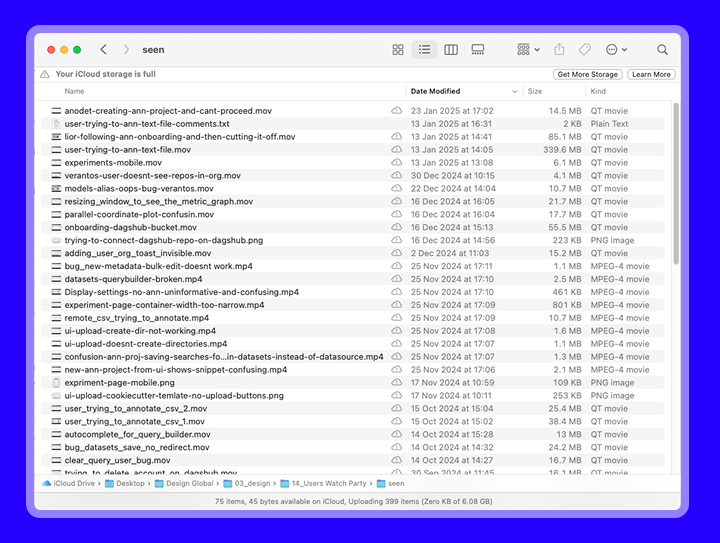DagsHub MLOps
2022 - 2025 | Lead Product Designer | B2B/B2C | MLOps platform
Embracing new role and domain
When I stepped into this role in 2022 — just before the initial AI boom of early 2023 — I entered an evolving domain with no established industry standards. AI development tools were rapidly advancing, and with that came inevitable growing pains. In many ways, I was growing alongside them. Transitioning from a structured, six-person product team at a large company to being the solo designer at a startup was both a challenge and an opportunity.
Key lessons I learned:
- Results over processes – Focus on outcomes rather than rigid methodologies
- Iterate quickly – Discard ideas that don’t work and move forward
- Visual storytelling drives impact – Transforming abstract concepts into visuals can significantly boost sales performance
Data management tool for ML Engineers
As we looked to expand beyond our existing features, I worked closely with the company owners to identify strategic opportunities through market and user research.
We discovered a major gap:
- ML Engineers needed an easy-to-use and powerful feature to visualize, query and version millions of data-points of their unstructured data
- Early feedback highlighted – all-in-one tool provides big value in a messy and diverse MLOps environment
- Need for seamless integration into current flows
To address this, I designed a sales demo prototype, and we validated our hypothesis through early customer feedback. From there, I conducted competitor research, stakeholder interviews, and user feedback sessions, iterating on the design. Adopting a design partnership strategy, we co-developed the feature with customers, refining it through direct insights and usage patterns.
2X
customers within 6 months
+7%
increase in conversion rate
+20%
increase in engaged users
The Data Engine successfully launched and is continuously evolving based on feedback. Its introduction doubled of paying customers within six months, proving its impact on business growth and user adoption.
Interactive pre-development mocks for sales processes
For almost every feature we identified as valuable for potential customers, I designed and built an interactive prototype in Figma.
Thanks to the Design System I created and maintained, I could generate high-quality mocks at lightning speed.
The process was straightforward: the founders would outline their vision, I would document it, ask clarifying questions, research similar market solutions, and create screens to illustrate the flow.
These initial mocks prompted deeper discussions, forcing stakeholders to consider technical constraints and refine requirements—especially with input from Dev Leads and other key team members. Through several iterations, we developed a solid visualization of the feature, which we then presented to clients or potential customers.
By rapidly prototyping in Figma, leveraging my Design System, and refining concepts through iterative collaboration, I helped the company to accelerate decision-making, align stakeholders, and ensure feature viability before development — saving time, reducing risk, and increasing the likelihood of market success.
Experiment table prototype
Nurturing UX maturity in the company
Many times in the company, we would have discussions around features and how they should look like. Initially, I always aimed for what I believed was the most seamless UX solution. But the common response was: Great in theory, but technical and time constraints mean we need a simpler, more rigid version for a quick release.
So, I adapted. I designed semi-ideal solutions that balanced usability and feasibility. Early discussions were often theoretical, making it difficult to convince developers that a bit more effort could dramatically improve UX.
The most powerful negotiation tool I discovered? User recordings. Watching users (especially if they were paying customers) struggle with a cumbersome flow or misunderstand an outcome was far more convincing than any argument I could make. Seeing friction firsthand turned skepticism into action. New tickets would be opened in the Product Backlog to gradually improve the UX.
Not usability testing, not surveys, not interviews—none proved as powerful in making a point during UX discussions. The "Users Watch Party" became a regular event in our weekly All-Hands meetings, providing a window for the team to see the impact of their work.

My folder named “Users Watch Party”
Another initiative I started was UX Updates Newsletter, where I shared the latest things we shipped with a focus on UX and their product impact. It was a way to keep the team aligned and motivated.
Overall, during my time at DagsHub,
- I drove end-to-end redesigns of essential user flows focusing on activation, simplification and retention (conducted usability testing, identified friction points via user recordings observation, usability testing)
- Established processes for effective collaboration with devs (built and shipped company's first Design System, led Figma Workshop for developers)
- Conducted user surveys, analyzed sales talks to identify customer expectation gaps and promote user-centered decision-making
- Nurtured UX maturity in the company (weekly User Recordings Replays, UX Updates Newsletter)